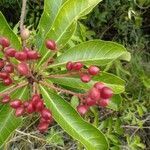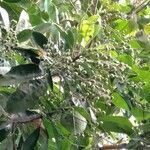Tree 4-35 m high and 10-75(-120) cm Ø; buttresses sometimes present, low, rounded, rarely up to 1 m high, 2 m extending outward from the trunk, and 10 cm thick. Leaves obovate to oblanceolate, or elliptic-oblong, 4½-26(-35) by 1¾-7(-9) cm, hairy beneath especially on the midrib when young, glabrescent; base cuneate to attenuate; apex usually obtuse or rounded, rarely apiculate, acute, or emarginate, rarely acuminate; nerves 7-18(-30) pairs, veins reticulate or reticulate-scalariform; petiole 1-3(-4) cm. Panicles 5½-22 cm long, hairy, glabrescent; bracts ovate or subro-tund, ½-⅔ mm long, sparsely hairy outside and ciliate on the margin, glabrescent, or glabrous; pedicels (l-)2-4 mm, usually not articulated. Flowers white. Calyx usually caducous, lobes broad-ovate or subrotund, ⅔-l mm long. Petals elliptic, 2½-3½ by 1¼-l¾ mm. Stamens 2½-3 mm; filaments 1¾-2½ mm, apically contracted and whitish; anthers ⅔-1 mm, sagittate, lower ⅓(-½) sterile. Disk ⅔-1 mm long. Carpels 1½-2 mm long. Drupe sublentiform, c. 10 mm Ø.
Tree to 15 m high (in Australia). Branchlets pubescent, glabrescent. Leaves obovate, oblong-obovate or oblanceolate, obtuse, sometimes acuminate, subcoriaceous, glabrous; lamina usually 5–26 cm long, 2–7 cm wide; base narrowly cuneate, decurrent; secondary veins mostly 9–22 pairs; tertiary veins scalariform-reticulate; petiole ± plano-convex, 0.5–2.5 cm long. Panicles to 22 cm long, ± appressed-pubescent, glabrescent; pedicels articulate 0.5–1 mm below base of calyx, or not articulate, sometimes with subtending bracts. Calyx lobes broadly ovate or rounded, 0.7–1 mm long, glabrous. Petals oblong-elliptic, 3–4 mm long, glabrous. Anthers 1–1.8 mm long; filaments 0.9–1.2 mm long. Carpels to 1.5 mm long; fertile one pilose. Drupe c. 10 mm diam.
Evergreen trees; branchlets minutely yellowish pubescent to subglabrous. Petiole 2-2.5 cm; leaf blade obovate-oblong to obovate-elliptic, 8-18 × 4-6 cm, leathery, glabrous, base cuneate, margin entire, apex rounded, lateral veins 10-15 pairs, prominent on both sides. Panicle terminal or axillary, 8-10 cm, minutely ferruginous pubescent. Flowers white. Calyx glabrous, lobes suborbicular, ca. 1 mm with ciliate margins. Petals elliptic to suborbicular, 3-4 mm, fleshy. Stamens equal to petals in length; filaments linear to subulate, longer than anthers; anthers sagittate. Disk large and thick. Carpels 5, minutely pubescent. Drupe lens-shaped, ca. 8 mm, glabrous. Fl. Mar, fr. Jul.



